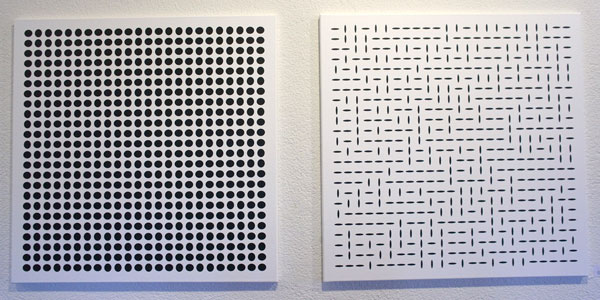Processing 'pour l'art'!
Reprint from my UI Design Blinks, originally published on the SAP Design Guild Website, now on walodesign.de
In a number of UI Design Blinks published last year (2011), I reported on my experiments with Processing, a Java-based programming language for designers. At that time, I had used it to create chart types that were not available in Microsoft Excel or, as I found out in the course of my experiments, would have been available if I had rearranged the data appropriately. This time, I would like to report on another type of experiment, namely "re-creating" computer art. My story goes like this.
Yesterday, I attended the vernissage of a new art exhibition in the SAP training center. The new exhibition features Vera Molnar, a pioneer in digital or computer art. Born in Hungary in 1924, she moved to Paris in the late 1940s and later became a lecturer at the Sorbonne University. Molnar started her pioneering work in the late 1960s, initially using her brain as a "simulated computer" (machine imaginaire) to execute algorithms that she had developed. Since 1968 she has been using real computers and plotters. Regrettably, due to her advanced years, Vera Molnar was unable to take part in the vernissage. The exhibition presents a number of prototypical works of Molnar's, including variations on the magic square (a square of 4x4 cells that is filled with numbers that add up to 34 in each direction – which maybe explains why some models of the VW Beetle had 34 horsepower...) (see Figure 2). These were inspired by an etching by Albrecht Dürer (see Figure 1), a well-known German artist from the Middle Ages. Molnar's work is based on the subtle balance between the principles of order and chance (or disorder). Another of her principles is the systematic variation of certain parameters, such as the form or degree of randomness. I will reveal one more of her principles at the end of this blink.
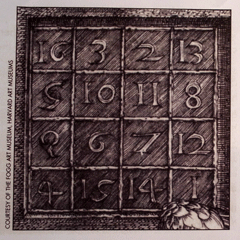 |
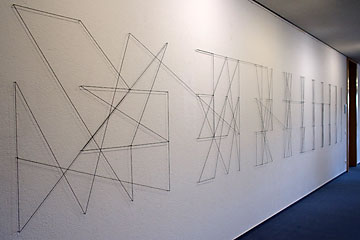 |
Figures 1-2: Albrecht Dürer's magic square, in which vertical, horizontal, and diagonal cells add up to 34 (left); some of Molnar's variations of the magic square created with threads and nails (right). Click images for larger versions.
My niece accompanied us to the vernissage and, while studying the various works, we engaged in the typical discussions about abstract art: "Could one create such a work on one's own?", and: "Is it really art?" When we encountered the following works (see Figure 3), I decided that I would at least try and see whether I could "re-create" their spirit:
Figure 3: Digital art by Vera Molnar – two variations of the same random pattern (click image for larger version)
Back home, I switched on my laptop and started Processing. Luckily, I still had the programs that I had used the previous year to create bubble charts. I decided that a program of this kind would be a good starting point for my attempts. To cut a long story short: After about an hour (and a major struggle with the programming language – due to my lack of familiarity with it), I ended up with the following results (see Figures 4 and 5):
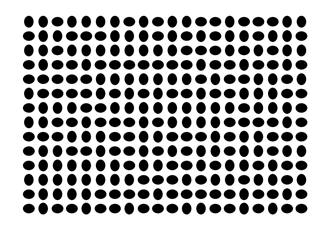 |
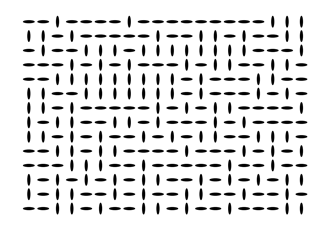 |
Figures 4-5: Digital "art" inspired by Vera Molnar – two variations of the same random pattern programmed with Processing (click images for larger versions)
I presented the results to my niece and my wife, and both agreed that I had successfully captured the "spirit" of Molnar's original work, including the visual perceptual effects that the "egg" version, in particular, elicited. Finally though, one question remains: Did I produce art? Of course, I didn't! And I say this for several reasons. Firstly, it was not an original idea of my own that I had implemented and, secondly, it was more or less my first (and last) attempt at this endeavor. Vera Molnar, on the other hand, creates myriads of variations on one idea and only selects the ones that really look "interesting" to her. And this leads me to the above-mentioned additional principle, namely "selection". Order is provided by arranging the "eggs" regularly in a grid; random variation refers to the random orientation of the "eggs"; systematic variation of parameters creates a huge space of results to select from and, finally, selection decides what is art and what isn't.
By the way: As my example demonstrates, it is much easier to copy or even fake digital art than traditional art...
References
- October 18, 2011: Processing "pour l'art"! (UI Design Blink)
- Vera Molnar (Philip Galanter)
- Vera Molnar's Website
- Casey Reas & Ben Fry (2007). Processing: A Programming Handbook for Visual Designers and Artists. The MIT Press, 2007 • ISBN-10: 0262182629, ISBN-13: 978-0262182621
- Processing Website
